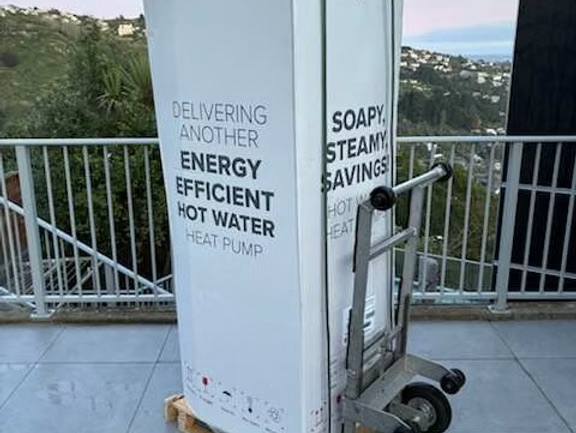
Hot water quietly eats a big slice of the average Kiwi home’s energy pie—around 30%. And unlike lighting or appliances, there’s usually just one machine behind it: the hot-water cylinder. Swap that one appliance and you can wipe out most of the slice.
That swap is a hot-water heat pump. Think of it as a fridge in reverse: instead of pulling heat out of food, it pulls heat from the surrounding air and pushes it into water. The key is that it moves heat rather than making it. For households staring down rising power bills, it’s one of the simplest, biggest wins—cutting both costs and emissions in one move.
How it works
A heat-pump water heater doesn’t burn gas or run a glowing electric element. Instead, it absorbs low-grade heat from the air, compresses it, and transfers that heat into your cylinder via a refrigerant loop.
Because moving heat is much more efficient than creating it, the savings are large. Most models use 60–75% less electricity than a conventional electric cylinder. Even compared with gas, they often come out ahead on running costs—without the fixed charges or fuel-price swings. You can calculate your savings using online tools like this free online calculator.
Why now
For years, hot-water heat pumps were niche. But a few things have changed in New Zealand:
- Household impact: With hot water sitting at roughly a third of household energy use, this is one upgrade with outsized returns.
- Policy and guidance catching up: EECA has released new installer guidance to improve sizing and installation so households actually get the promised efficiency. Standards NZ has also updated its rules for high-temperature heat pumps, broadening them to cover domestic hot water.
- Grid alignment: As the Ministry of Business, Innovation and Employment points out in its latest energy outlook, New Zealand is steadily shifting to a cleaner, renewables-heavy electricity grid. Electrifying hot water dovetails perfectly with that trajectory.
Cold-weather reality
The obvious question: what about winter?
Field data shows modern hot-water heat pumps still perform well in freezing conditions. Efficiency does dip in sub-zero temperatures, but the gains remain. A UK government-backed study found median “coefficient of performance” (COP) above 2 on very cold days, and around 2.9 averaged across the year.
The takeaway: with proper specification and installation, they keep delivering—even when you can see your breath.
What homeowners should check
Before making the switch, it pays to consider a few practicalities:
- Fit and sizing: Match the cylinder to family size, shower habits, and climate.
- Noise and placement: Units need outdoor clearance, and some make noise during defrost cycles.
- Tariffs and timers: Time heating to cheaper tariffs, or sync it with rooftop solar if you have panels.
- Installer competence: Ask about expected COP at 7 °C, recovery time for your cylinder size, and how the system handles defrost. EECA’s new guide is designed to lift the quality and consistency of installations nationwide.
Costs and savings
For a typical household, the numbers add up fast. Across a year, many families see their hot-water electricity use fall by two-thirds or more compared to a standard element cylinder. Larger households, with higher hot-water demand, save the most in absolute dollars.
For gas users, switching also means shedding the fixed connection charges and dodging the volatility of gas prices. Exact savings vary depending on tariffs, usage, and location, but the direction is clear.
The bottom line
One appliance change. Long-term savings. A quieter emissions profile.
For many New Zealand households, the hot-water heat pump is the lowest-friction path to a smaller bill and a smaller footprint. The technology isn’t flashy, but it’s here, proven, and ready. Sometimes the biggest revolutions are the quiet ones—humming away at the side of your house, making every shower and dish cycle cleaner and cheaper.







